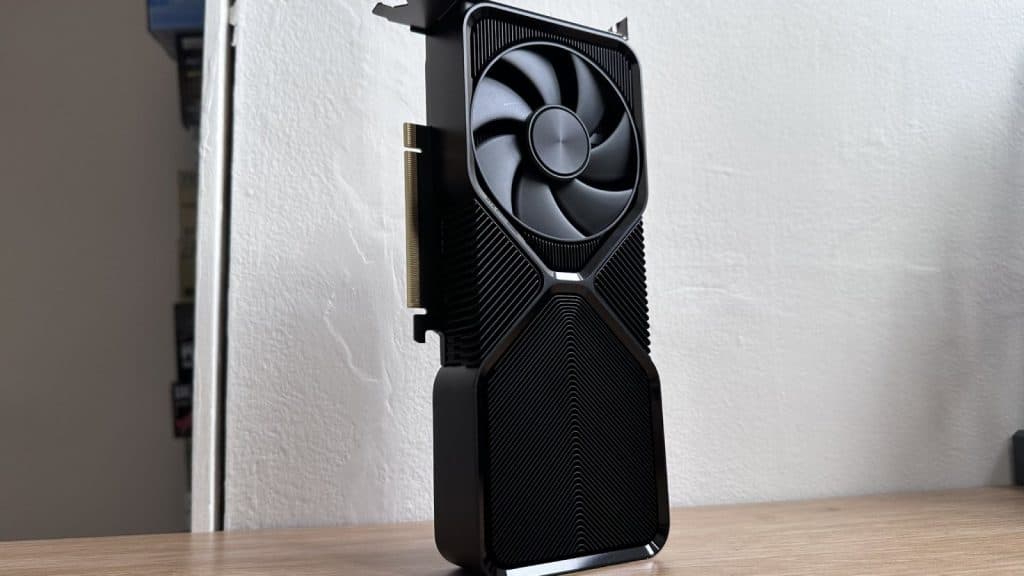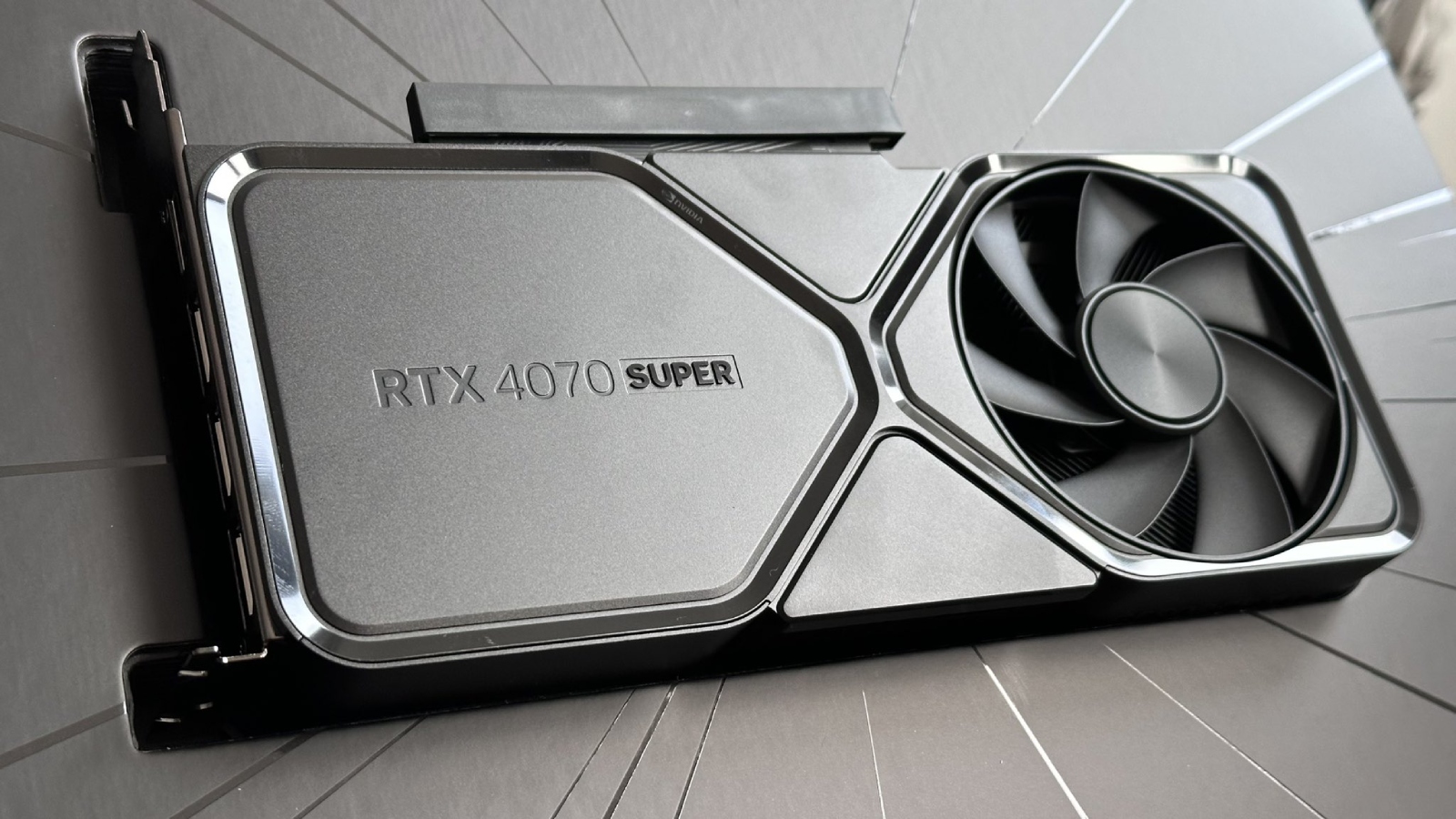Nvidia’s RTX 4070 Super has landed, and we’ve tested it to its limits to see just how much of an upgrade the new GPU is compared to its predecessor: Spoiler alert, it’s great.
Nvidia’s RTX 4070 was launched just under a year ago, but Nvidia seems to be feeling the heat from competitors like AMD, with its stellar RX 7800 XT graphics card. In response, Team Green has retaliated with the Super lineup, which introduces the RTX 4070 Super, 4070 Ti Super, and 4080 Super.
Announced at CES 2024, these graphics cards are being released in inverse order, with the 4070 Super up first, and the 4080 Super last. But, should you be paying attention to Nvidia’s successor to its most popular desktop 40-series GPU? We dive deep and find out whether this is the GPU upgrade for you.
Key specs

Design
The RTX 4070 Super Founders Edition uses the same thermal solution as its original variant, with a couple of key differences. Still present is a dual flow-through design, which is complemented by an all-metal chassis. But, there’s one key difference between this and the previous RTX 4070 that Nvidia released: It now sports a blacked-out look. From the aluminum frame to the plastic above and dark metal accents, this GPU looks fantastic.
I already am a huge fan of the current crop of Nvidia Founder’s Edition graphics cards, and these blacked-out versions make them all look even better. While it’s all cosmetic changes on the surface, the innards of Nvidia’s new GPU are very different from its predecessor.
Sporting Nvidia’s AD104 chip, you can expect a significant boost in power, thanks to a bigger die, as well as a boost in overall CUDA cores, when compared to the RTX 4070. With an additional 20W of power by its side, you should expect performance to be approaching similar levels to the RTX 4070 Ti.
Cache & VRAM
Nvidia originally listed the RTX 4070 Super as having the same 36MB of L2 cache as the standard 4070. However, this was revised to 48MB of L2 after the announcement. According to Nvidia, larger cache sizes can have a direct impact on performance and efficiency, without having to rely on more memory bandwidth.
Nvidia’s cache claims have served largely as a rebuttal toward their approach to VRAM with the RTX 40-series. While it would have been great to see the VRAM capacity get upgraded from 12GB of GDDR6X to 16GB, an Nvidia representative told Dexerto that upgrading the memory capacity on the card would have impacted the overall cost of the GPU.
Performance
The RTX 4070 Super is being positioned by Nvidia as a 1440p-focused card. This means that the GPU will likely fit into a sweet spot of users who want to go above 1080p resolutions, but do not want to stretch their budgets out for full 4K. Regardless, we will benchmark the GPU at 4K to see just how well this graphics card performs, just in case you’re on a budget.
The RTX 4070 Super will likely be overkill for 1080p users, but if you want to attain competitive framerates in esports titles, we will still benchmark the GPU for this purpose.
We will also use DLSS 3 performance in certain titles as a barometer for RT-heavy workloads. We have chosen not to opt for any RT Overdrive options, outside of Cyberpunk 2077, as very few titles use fully path-traced lighting at the time of review.
Test System
- CPU: AMD Ryzen 7 5800X3D
- CPU Cooler: Cooler Master PL360 Flux
- Motherboard: NZXT B550
- RAM: 32GB Corsair Vengeance DDR4 @ 3600 MHz
- Case: Lian Li Lancool II Mesh
- PSU: Cooler Master MWE Gold V2 850W
Our test system should stack up to most midrange systems, and provide similar performance to our 13600K system, allowing for similar levels of performance. When testing the same GPU in the other testbench, results between the two were accurate in gaming workloads to 2-3%.
RTX 4070 Super 4K gaming performance
Starting with 4K benchmarks, the RTX 4070 Super manages to attain more than playable framerates in certain titles. However, for games that use path-traced lighting, these numbers might be a touch lower as the GPU begins to struggle with VRAM capacity.
The RTX 4070 Super, while not strictly marketed as a 4K GPU, does manage to perform at 60FPS in heavily ray-traced workloads using DLSS 3. In terms of pure rasterization performance, it managed to outshine the RX 7800 XT in many benchmarks, as well as being a good deal quicker than the original RTX 4070 by around 12%.
It should be noted that despite retesting multiple times, our results in Cyberpunk 2077 are lower than that seen by the original RTX 4070. This phenomenon only seems to occur when testing at 4K.
Compared to the RX 7800 XT, the RTX 4070 Super’s biggest competition, it comes out on top by also being 12% faster, too. Though it’s not strictly marketed as one, you’ll still be able to get playable framerates out of the most demanding games at 4K.
RTX 4070 Super 1440p gaming performance
1440p is where the RTX 4070 Super flourishes in every aspect. You get a nice boost in pure rasterized workloads thanks to the higher CUDA core count. Compared to the RTX 4070, you can expect it to be at least 10% faster than the RTX 4070 in our benchmarks, and around 17% faster than an RX 7800 XT, bearing in mind the AMD benchmarks use FSR 2. It falls short of the RTX 4070 Ti by around 4%, which is an extraordinary value considering the difference in MSRP between the GPUs.
RTX 4070 Super 1080p gaming performance
At 1080p, the RTX 4070 Super manages to perform incredibly well, which highlights the power of the graphics card. If you want something purely for gaming at competitive framerates, this GPU will manage to offer a great deal of power without breaking the bank entirely.
Though I still think the card is overkill at this resolution, don’t let that detract you from the very real use case of wanting to use it to power games with incredibly high framerates. As refresh rates get higher, sometimes getting a smooth image is paramount above all. Here, the RTX 4070 Super outperforms the RTX 4060 Ti by 30%, and the RTX 4070 by 12%. If you’re targeting this resolution, it’s worth paying the extra $50 over the original RTX 4070 to get a nice bump in performance.
Synthetic benchmarks
The RTX 4070 also performed well under our suite of synthetic benchmarks, which evens out as being 14% faster than the original 4070. It’s also faster than the RX 7800 XT by 21% and falls short of the RTX 4070 Ti’s prowess by just 8%. It sits firmly in the middle, between the RTX 4070 and 4070 Ti.
Thermals, power & efficiency
The RTX 4070 Super drinks just 20W more power than the original model, but when pushed to the brink in gaming workloads, we saw the wattage top out at 212W, which is great, considering the extra performance we’re getting here. We also saw clocks boost above the rated boost clock to around 2695 MHz.
All the while, the Founders Edition GPU managed to keep itself at a maximum of 83 degrees under load. The fan noise was never really noticeable, though there was coil whine present when the GPU was pushed and pushing high framerates.
Should you buy it?
The RTX 4070 impressed us upon its release, by essentially being a parallel to an RTX 3080, with more VRAM and handy frame generation features. However, the GPU’s only foil was that the card didn’t match up to performance expectations when it came to generational uplift. If you cast your mind back to the RTX 30-series, the original 3070 matched up to the performance of a 2080 Ti. Now, the RTX 4070 Super looks to absolve Nvidia of this issue entirely, by offering up RTX 3090-level performance at an accessible price.
While our only criticism of the VRAM capacity remains, the RTX 4070 Super is everything the original card should have been at launch. It’s easy to rake Nvidia over the coals when a GPU releases, and it’s not quite as good as everyone expects. But, you have to equally give Team Green some credit here. The 4070 Super simply trounces the current competition from the RX 7800 XT by offering faster performance all-round and DLSS 3’s frame-generation features, as well as better Ray Traced performance for a slight premium.
Verdict: 5/5
I get a lot of questions about which GPU people should buy, and it’s always been quite difficult to answer. But, Nvidia has handed the answer to me on a silver platter. This is the go-to GPU for people looking for the ideal price-to-performance ratio on the market as it stands. You also get heaps of extra Nvidia AI software features in Broadcast, Reflex, and more.
No matter if you’re looking for a card that can manage adequate 4K, great 1440p, or blazing 1080p framerates, the RTX 4070 Super has it all. At this mid-to-high-end price point, this GPU is simply unbeatable. I just wished that it had come out earlier.
If you click on a product link on this page we may earn a small affiliate commission.


